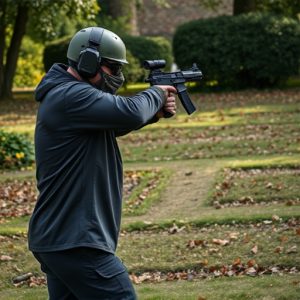Unveiling Self-Defense Secrets: Disguised Stun Gun’s Impact on Spread Patterns
The effectiveness of disguised stun guns as self-defense tools relies on understanding how electrica…….
The effectiveness of disguised stun guns as self-defense tools relies on understanding how electrical current spreads, influenced by voltage and resistance. By optimizing device circuitry, manufacturers can deliver powerful yet controlled jolts to neutralize attackers without permanent harm. This compact, discreet tool offers non-lethal deterrence, providing users with crucial time to escape or seek help in various situations. Analyzing electrical current flow is key to developing safe and effective disguised stun gun self-defense tools, minimizing collateral damage and ensuring user protection even in complex environments.
Electrical current’s spread patterns hold unexpected insights into self-defense strategies. Understanding how energy flows can transform everyday objects into powerful tools, like the disguised stun gun, is crucial for personal safety. This article explores the science behind electrical current and its behavior, delving into how specific spread pattern analysis can enhance self-protection strategies using disguised stun gun self-defense tools. By the end, readers will grasp the significance of these techniques in real-world scenarios.
- Understanding Electrical Current and Its Behavior
- The Disguised Stun Gun: A Tool for Self-Defense
- Analyzing Spread Patterns: Enhancing Self-Protection Strategies
Understanding Electrical Current and Its Behavior

Electrical current, a flow of charged particles, forms the backbone of many technologies we rely on daily. When it comes to self-defense tools like disguised stun guns, understanding how this current behaves is paramount. The spread pattern of electrical current depends on various factors such as voltage, resistance, and the medium through which it flows. In the context of a stun device, the current seeks the path of least resistance, aiming to deliver a powerful jolt to disrupt an attacker’s nervous system.
This phenomenon allows for the effective neutralization of a threat actor without causing permanent harm. By analyzing the spread pattern, manufacturers can design more efficient and targeted self-defense tools. This involves optimizing the device’s circuitry to ensure the current is concentrated enough to be potent yet controlled enough to minimize collateral damage. Such considerations are crucial in the development of modern self-defense technologies, especially when aiming to create compact, discreet devices like disguised stun guns.
The Disguised Stun Gun: A Tool for Self-Defense

In the world of self-defense, innovative tools are constantly emerging to provide individuals with added safety and peace of mind. One such game-changer is the disguised stun gun—a compact and unassuming device that packs a powerful punch. This tool is designed to look like everyday items like flashlights or keychains, making it an excellent option for those seeking discreet self-defense options. Its sleek and subtle design allows users to carry it almost anywhere without raising unnecessary attention, ensuring folks can stay prepared in various settings.
The disguised stun gun offers a non-lethal way to deter potential attackers, providing users with time to escape or call for help. With just a quick trigger, the device delivers an electric shock that temporarily disables an assailant, giving the user a crucial advantage. This self-defense tool is especially valuable in situations where a traditional weapon might not be appropriate or easily accessible, making it a versatile addition to personal safety strategies.
Analyzing Spread Patterns: Enhancing Self-Protection Strategies

Analyzing the spread pattern of electrical current is a critical aspect of developing effective self-defense strategies, especially when it comes to disguised stun gun self-defense tools. By understanding how energy flows and disperses, manufacturers can design devices that deliver precise and powerful shocks while minimizing risks to users and bystanders. This analysis involves meticulous research into the physics behind electrical conduction, including factors like current density, voltage drop, and resistance variations across different materials and body types.
Such insights enable engineers to create compact yet high-performance stun guns that maximize the impact of each pulse. For instance, understanding current spread patterns can lead to the development of tools with targeted discharge capabilities, ensuring minimal collateral damage while effectively immobilizing an assailant. This is particularly crucial in scenarios where bystanders are nearby or when dealing with multiple attackers, making hidden self-defense tools more reliable and safer for personal protection.
Electrical current spread pattern analysis is a crucial aspect of enhancing self-protection strategies, especially when utilizing innovative tools like the disguised stun gun. By understanding how electrical current behaves and analyzing its spread patterns, individuals can make informed decisions in potentially dangerous situations. This knowledge enables users to employ the disguised stun gun as an effective self-defense tool, ensuring safety and peace of mind. In today’s world, staying prepared and informed about such tactics is vital for personal protection.


